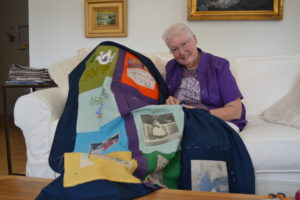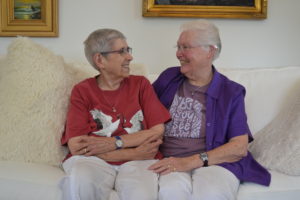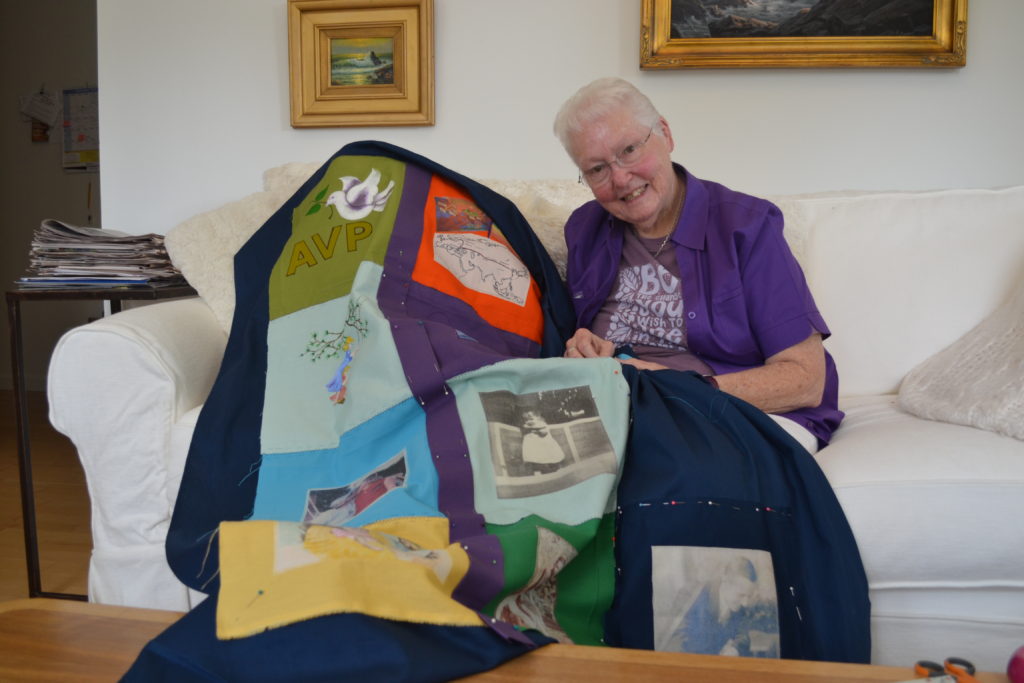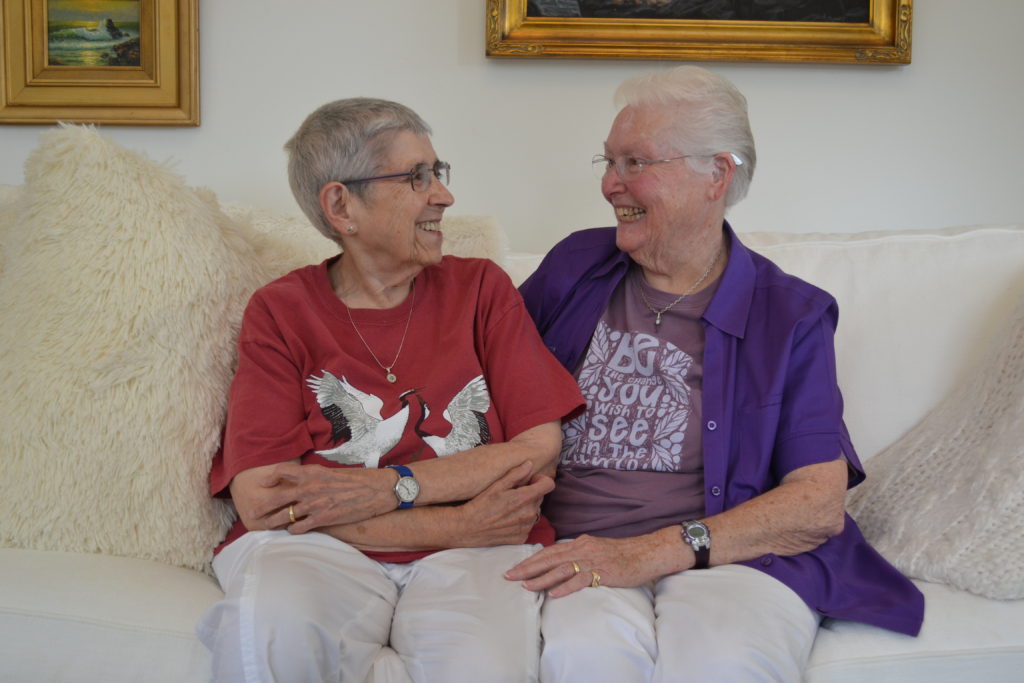When she was 37, Edie Daly came out as a lesbian. It was 1974, in the suburbs of New York City. Firmly ensconced in a 17-year marriage to a man, Daly had three children. The woman she fell in love with — a co-worker at a local school — also had a husband and four children.
Daly knew she was in love, and the time had come to act. But she also knew that coming out would mean the dismantling of two traditional families, and a level of candor with parents, husbands, and children that would not only shock and confuse, but which needed to be shared during an era without commonly accepted terms for what it meant to be gay.
“It wasn’t safe for us to be out,” Daly tells me. She sits on a large white couch in her sunlit Northampton apartment, her hands in her lap, while her wife of 20 years, Jackie Mirkin, sits nearby. “So we had to hide who we were.”
“We would have both lost our jobs,” Daly says, referring to her first female partner. “She would have lost her children, for sure, because they were foster kids through the Jewish Child Care Association. And my kids — my husband could have made a big stink and taken them away from me.
“It was not an easy time,” she says. “It was very scary.”
 ,
,
Daly, who was born during the Great Depression, recently turned 80. Over the decades, she has experienced firsthand the thrilling and troubled uncovering of gay and lesbian America — populations that were invisible as recently as the 1950s, but whose decades-long fight for legal and cultural recognition has educated and transformed the nation.
On Thursday, Sept. 29, Daly will share some of her memories and refelctions on this transition with help from nine of her “old lesbian” friends, at “An Old Lesbian Memory Quilt Story.” The event will run 6:3-8:30 p.m. at the Sophia Smith Collection at Smith College, and will feature readings from several chapters of Daly’s journals. Afterward, visitors will be invited to share their own thoughts and memories.
Daly is an eloquent writer and speaker, but much of what will be read hasn’t been publicly shared during the Memory Quilt Story hasn’t been made public before. It should prove illuminating.
Finally acting on her love for women at age 37 was “very exciting,” Daly says, “because finally I was being who I am — who I’d been hiding all those years. I had been hiding from myself as well as from other people. So, when we began to find women, it was just amazing.”
Daly describes her divorce as “amicable.” That, in itself, was no guarantee. But once she explained her true feelings to her husband, they were able to speak constructively about separating. “It was so interesting,” she says. “He was able to understand that it wasn’t his fault — that I love women. And he was able to leave.”
Coming out to the three kids took longer. At the time, Daly’s youngest was 12, and the oldest was 16.
“We had to keep it a secret from them,” she says. The parents set a rule: tell the children when they turn 21, or when they ask about it — whichever comes first.
One of Daly’s sons asked when he was 19. “So we told him. And I started by apologizing to him for lying to him. I explained why we couldn’t be out. We told all of the rest of the kids within that week.”
“Most of them accepted it fine,” she adds. “They just had questions about it. This life was all so hidden at that time. I didn’t even know it was a possibility myself, until I fell in love.”
The children stayed with Daly’s husband, while she and her first female partner moved to Daly’s home state of Florida in 1981, where they opened a feminist women’s bookstore and started a monthly series of salon-style gatherings.
“Within a couple of months, we knew 250 [lesbian] women, living in St. Petersburg,” she says. “The salon went for 25 years, and we all grew together. That’s how we learned feminism. It’s how we learned consensus decision-making. It’s how we learned process. We read. We went to festivals together. We went to conferences. It was heady times.”
For the past two decades, Daly has also worked as an interviewer with the Old Lesbian Oral Herstory Project, which has conducted more than 500 interviews. The Sophia Smith Collection at Smith College now houses 350 of these interviews, and is set to take in more — another reason why Daly is enthusiastic about drawing interested listeners to campus on the night of the 29th.
“When we were just starting out,” she explains, “many of the first old lesbians we interviewed were born in the early 1900s. At this point, many of them have passed.”

Death is an ongoing topic in Daly’s social circles, which are comprised mainly of women in their 70s and 80s.
“We talk about how we want to die,” she says. “We don’t hide that from conversation. Lots of old people have family that takes care of them. Lesbians don’t necessarily have that. So we talk a lot about taking care of each other, and about community, even though we’re not all living together.”
Daly and Mirkin keep a home in Florida, but they have spent summers in Northampton for the past decade. Up here, they have found many of their old lesbian friends through the Valley’s local chapter of OLOC: Old Lesbians Organizing for Change.
“That’s how I met Edie, about five years ago,” says Michele Reiter, a 73-year-old retired psychotherapist who has lived in the Valley for 44 years. “She and Jackie came to our first meetings and helped us form the group. Right away, I saw someone who was a leader, who knew how to live by example.”
Daly interviewed Reiter for the Old Lesbian Oral Herstory Project, and Reiter’s is one of the stories that will be archived at Smith. Reiter, who also came out in the mid 1970s following a marriage to a man, was an emcee at the first Northampton Pride march in the early 1980s.
“A lot of us have been here a very long time, but we hadn’t had a social or political group for many years,” she says. “We had all simply been aging and raising our families, somewhat disengaged from each other. Through OLOC, I think it’s become a more vibrant community … A lot of us led very traditional lives before coming out.”
“All of a sudden, you’re discovering this dormant part of your personality,” she adds. “You feel very adolescent. You’re going through something that’s new and different, and also uncomfortable. You go from feeling wise and mature to feeling brand-new again.”
Another of Edie’s old lesbian friends, who preferred to be named only as Ellen, says she feels “it’s important that we give voice to ourselves more often. We’re a population that’s not noticed very much.”
Ellen will be reading from a chapter describing the founding of Edie’s bookstore in Florida. “Edie’s great. She’s really a mover and a shaker,” Ellen says. “I can really relate to her story.”
Meanwhile, Ellen has shared own story through the oral history project. Over time, those stories become an interlocking array of personal histories, much like a quilt.
Even within one old lesbian’s mind, Edie tells me, the years have not unfolded in straight lines. It’s why she began, earlier this year, to turn her memories into a literal quilt, with 12 squares representing specific periods and moments in her life.
“I don’t tell my story chronologically,” she says. “I tell it more like a patchwork. That’s why I don’t call them my memoirs. It’s a memory quilt. My activism, my marriage, my kids, coming out, my relationship with Jackie … I really want to look at how the squares fit together and complement each other. How they’re dissonant. And how the colors come together.”
Contact Hunter Styles at hstyles@valleyadvocate.com.




